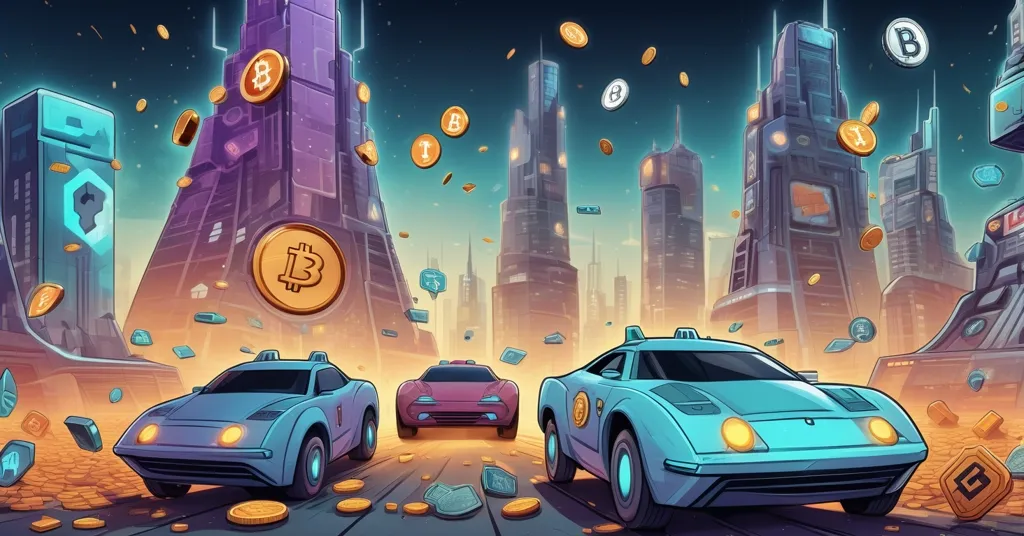BlockDAG’s $430M Presale: Real Crypto Potential or Just Another Hype Trap?

BlockDAG’s $430M Presale: Legit Crypto Gem or Hype Trap in a Market of Fading Meme Coins?
With meme coins like Dogecoin, Shiba Inu, and Pepe losing their grip on investor enthusiasm, BlockDAG (BDAG) has stormed onto the scene, raising over $430 million in its presale and promising explosive returns. As the crypto market craves projects with real substance over viral gimmicks, we’re diving deep into whether BlockDAG is a genuine contender for 2025’s breakout star or just another presale mirage. Let’s cut through the noise and see what’s really at play.
- BlockDAG’s Big Claims: $430M raised, 27 billion coins sold, and a potential 32x ROI at launch.
- Meme Coin Decline: DOGE, SHIB, and PEPE struggle without solid fundamentals or roadmaps.
- Reality Check: Is BlockDAG the future, or are we falling for well-polished hype?
Meme Coins: A Fading Frenzy
The crypto space has long been a wild west of speculation, where a clever meme can turn pocket change into fortunes overnight. Dogecoin (DOGE), the original meme coin, still clings to relevance thanks to cultural clout and sporadic endorsements from Elon Musk via X.com or Tesla-related buzz. But let’s not sugarcoat it—DOGE lacks basic tokenomics, the economic model of a cryptocurrency that includes supply rules, distribution, and incentives. With no capped supply (about 5 billion new coins are minted annually) and no staking mechanism to reward holders, it’s a speculative toy, not a serious asset. Its value spikes are just digital lottery tickets, and latecomers often end up burned when the hype fades.
Shiba Inu (SHIB), once hyped as the “Dogecoin killer,” made waves in 2021 with astronomical returns, but its momentum has stalled. The launch of Shibarium, a Layer 2 network designed to process transactions off the main Ethereum chain for faster, cheaper operations, was supposed to be a game-changer. Yet, transaction volume on Shibarium remains underwhelming, and the token burn mechanism—meant to reduce supply and theoretically boost value—has been inefficient, with negligible impact on price. Without fresh catalysts or a clear reward schedule, SHIB is stuck in neutral, leaving investors wondering if the dog has had its day.
Then there’s Pepe (PEPE), a frog-themed token that leaped into the top 100 cryptocurrencies shortly after launch, fueled by pure memes and fear of missing out (FOMO). It’s a laugh, sure, but beyond internet chuckles, there’s nothing—no roadmap, no ecosystem, just a digital gag waiting for the joke to wear thin. Floki (FLOKI) at least tries to differentiate itself, aiming to build a broader ecosystem with metaverse gaming, DeFi integrations, and educational initiatives. But progress is uneven, adoption lags, and it’s still tethered to meme coin volatility. These projects thrive on sentiment, not structure, making them a risky bet in a market starting to demand more. For a deeper look into the fading steam of meme coins like DOGE, SHIB, and PEPE, their struggles highlight the shift toward projects with stronger fundamentals.
BlockDAG’s Bold Claims: A $430M Presale Powerhouse
Against this backdrop of fading meme mania, BlockDAG (BDAG) is making a loud entrance. Having raised over $430 million in its presale with more than 27 billion coins sold across 31 batches, the numbers alone turn heads. Priced at $0.0304 in the latest batch, early investors have reportedly seen a staggering 2,940% return since Batch 1. For those eyeing a piece of the action, a limited-time entry price of $0.0015 with the code “TGE” offers a low barrier. BlockDAG is also touting a confirmed listing price of $0.05, which could mean a 32x return on investment (ROI) at launch. To break it down, if you put in $1 now, it could be worth $32 when trading starts—but only if that target price holds, which is far from guaranteed in this volatile space.
What makes BlockDAG stand out, at least on the surface, is its structured approach. Unlike the chaotic hype of meme coins, BDAG introduces a rank-based airdrop system tied to its upcoming Genesis Day on November 26. An airdrop, for the uninitiated, is a distribution of free tokens to holders or participants, often as a reward or to drum up interest. Here, the top 300 ranks get instant airdrops on Genesis Day, while lower ranks face delayed payouts—a smart nudge to get in early and stay active. Add to that a Binance AMA (Ask Me Anything) set for October 24 at 3 PM UTC, alongside announcements for Keynote 4 and Genesis Day, and you’ve got serious exposure on one of the biggest exchanges out there. These milestones suggest BlockDAG is playing for keeps, not just memes.
Credibility also comes from real-world moves. A partnership with the BWT Alpine Formula 1® Team signals branding beyond the crypto bubble, a rarity for presale projects. Security audits by CertiK and Halborn, two heavyweights in blockchain vetting, add a layer of trust, assuring investors the tech isn’t just smoke and mirrors. Compared to meme coins, where transparency is often a dirty word, BlockDAG seems to be building a foundation for the long haul. But let’s not get carried away—presale promises are cheap, and the crypto graveyard is full of projects that dazzled early only to flop spectacularly.
Tech Behind the Hype: What Is BlockDAG Really?
Beyond the flashy numbers, BlockDAG’s tech is worth a closer look. The project uses a Directed Acyclic Graph (DAG) structure, a departure from the linear blockchain model of Bitcoin or Ethereum. Think of traditional blockchains as a single-file line—transactions are processed one after another, which can lead to bottlenecks and high fees during peak demand. A DAG, by contrast, operates like a web, allowing multiple transactions to be confirmed simultaneously, promising greater scalability and speed. For a market hungry for solutions to Ethereum’s gas fees or Bitcoin’s slower confirmation times, this could be a big deal—if it works as advertised.
Yet, specifics on BlockDAG’s roadmap post-Genesis Day are thin. What are the use cases? How does it stack up against other DAG-based projects like IOTA or Hedera Hashgraph, which have wrestled with adoption challenges despite similar tech promises? Without concrete milestones or real-world testing data, it’s hard to gauge if this is a genuine innovation or just a buzzword-laden pitch to lure investors. The audits and partnerships help, but tech is only as good as its execution, and we’ve yet to see BlockDAG under pressure.
Risks and Red Flags: Playing Devil’s Advocate
Let’s pump the brakes on the hype train and look at the flip side. Presale success doesn’t equal long-term value. History is littered with projects like EOS, which raised billions in 2017-2018 only to underdeliver on utility, or worse, BitConnect, an infamous Ponzi scheme that collapsed after dazzling investors with impossible returns. BlockDAG’s promised 32x ROI sounds seductive, but it hinges on market conditions, post-launch liquidity (the ability to easily buy or sell without crashing the price), and actual adoption. If buyers vanish or the project fails to deliver on tech promises, that $0.05 listing price is just a pipe dream. And let’s be blunt—if someone’s guaranteeing you a 32x return in crypto, run. This isn’t a crystal ball; it’s a gamble.
Another concern is the promotional sheen. The rank-based airdrop, while innovative, could disproportionately reward early whales—big investors who scoop up huge chunks early—while smaller players get delayed payouts. Is this truly decentralizing wealth, or just a clever way to prioritize the already-rich? Plus, the heavy focus on presale milestones and AMAs reeks of marketing over substance. Crypto is about freedom and sticking it to centralized systems, but too often, presales become centralized cash grabs dressed as revolution. BlockDAG needs to prove it’s more than a polished pitch.
Bitcoin, Altcoins, and the Bigger Picture
As someone with a Bitcoin maximalist streak, I’ll always root for the OG king of decentralization. Bitcoin’s simplicity, security, and unyielding focus as a store of value remain unmatched. No altcoin will ever dethrone it in my eyes. But I can’t ignore that altcoins carve out rebellious paths of their own, filling niches Bitcoin doesn’t aim to serve. Ethereum brought smart contracts; others like BlockDAG push scalability experiments. If they deliver, they can drive the industry forward, even if half the projects out there are pure snake oil.
The broader market is shifting too. After the 2021 bull run crowned meme coins as retail darlings, the 2022 bear market sobered everyone up. Investors now crave fundamentals, especially as regulatory scrutiny tightens and macroeconomic factors like rising interest rates squeeze risk assets. BlockDAG’s structured approach could appeal to this maturing crowd, tired of meme coin roulette. But until we see post-launch performance or tangible adoption, it’s all speculative buzz with a shiny bow. Social media sentiment—whale activity on X or Telegram—shows hype, but hype alone built no empires.
New to Crypto? Start Here
If you’re just dipping your toes into this space, here’s a quick primer on navigating presales like BlockDAG. First, read the whitepaper—every legit project has one detailing its tech and vision. Check the team’s credibility; anonymous founders are a red flag. Look for audits (BlockDAG’s got CertiK and Halborn, a good sign) to ensure the code isn’t a ticking time bomb. And above all, ignore FOMO-driven shills promising moonshot gains. Crypto is about calculated risks, not blind bets. Start small, stay skeptical, and remember: if it sounds too good to be true, it probably is.
Final Verdict: Bet or Bust?
Meme coins like DOGE, SHIB, and PEPE are sputtering without the fundamentals to keep the engine running, while BlockDAG is making a compelling case as the next big thing. I’m all for disrupting the status quo and accelerating innovation—effective accelerationism is how we win—but let’s ditch the rose-colored glasses. BlockDAG’s presale haul, partnerships, and tech pitch are intriguing, yet the road to crypto glory is paved with broken promises. For every Bitcoin or Ethereum, there are countless rug pulls and faded dreams. Cheer for the underdog, but keep your guard up.
As Genesis Day on November 26 and the Binance AMA on October 24 approach, the spotlight on BlockDAG will only get brighter. For newcomers, this is a chance to learn the difference between a viral fad and a calculated play. For seasoned OGs, it’s a reminder to question everything, even the slickest new contender in the ring. Crypto is about freedom, privacy, and challenging the centralized overlords—but only if we back projects that walk the talk. Will BlockDAG redefine altcoin investing, or join the pile of overhyped failures? Time, and ruthless scrutiny, will tell.
Key Takeaways & Questions for Crypto Enthusiasts
- What makes BlockDAG a potential breakout crypto for 2025?
With a $430 million presale, 27 billion coins sold, a rank-based airdrop system, and partnerships like BWT Alpine Formula 1®, it stands out from meme coins, promising a 32x ROI at a $0.05 listing price. - Why are meme coins like DOGE, SHIB, and PEPE losing traction?
They lack sustainable tokenomics—DOGE has endless inflation, SHIB’s Shibarium underdelivers, and PEPE offers no roadmap—relying on fleeting social buzz for value. - Does a massive presale like BlockDAG’s guarantee future success?
No, while the numbers are impressive, success depends on post-launch adoption, market conditions, and execution—factors that could derail even the best-funded projects. - How important are partnerships and audits for trust in new crypto projects?
Extremely; BlockDAG’s Formula 1 tie-up and audits by CertiK and Halborn signal legitimacy, unlike many meme coins with zero accountability or transparency. - Should investors pivot from meme coins to structured projects like BlockDAG?
It’s a personal call—meme coins can yield quick, erratic gains, while structured projects might offer stability, but only if they deliver on promises, which is never a sure bet.



